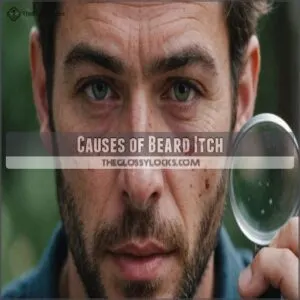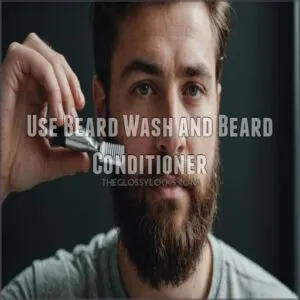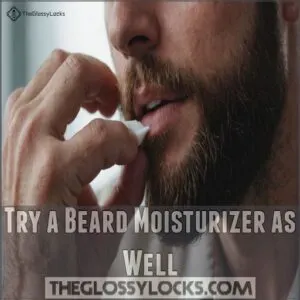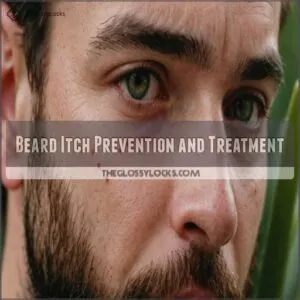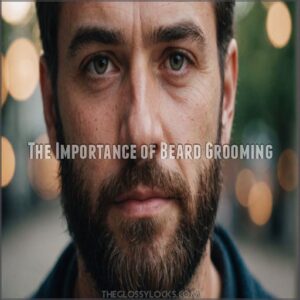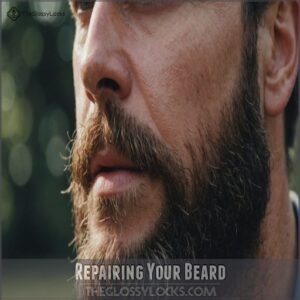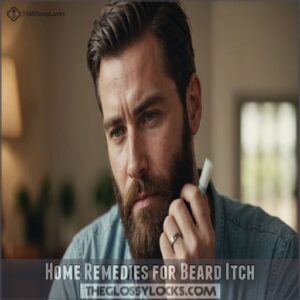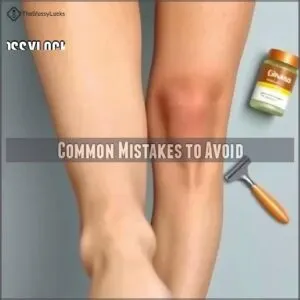This site is supported by our readers. We may earn a commission, at no cost to you, if you purchase through links.
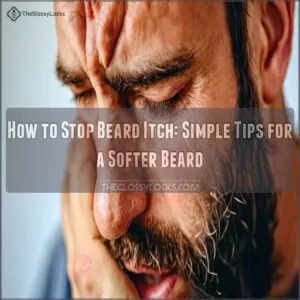 Stopping beard itch isn’t as tricky as herding cats, but it does require a little TLC.
Stopping beard itch isn’t as tricky as herding cats, but it does require a little TLC.
Start by brushing with a boar bristle brush to sweep away pesky dead skin.
Wash your beard a few times a week using natural products and follow with a conditioner for that silky feel.
Don’t skimp on beard oil or moisturizer; they seal in hydration and fend off itchiness.
Eating omega-rich foods can boost your beard from the inside.
Remember, a well-nourished beard is a happy beard!
Curious about more beard care secrets? Stick around for tips to make your beard as smooth as you are.
Table Of Contents
- Key Takeaways
- Causes of Beard Itch
- How to Stop Beard Itch
- Beard Itch Prevention and Treatment
- The Importance of Beard Grooming
- Repairing Your Beard
- Nutrition and Diet for Beard Health
- Home Remedies for Beard Itch
- When to Seek Medical Attention
- Common Mistakes to Avoid
- Maintaining a Healthy Beard
- Frequently Asked Questions (FAQs)
- How to get rid of beard itch?
- What can I do for an itch that has suddenly become unbearable?
- How do you keep a beard dry & itchy?
- How to keep a beard Itch at arm’s length?
- What can I put on my beard to stop itching?
- Why is my beard so itchy when growing?
- How to make a beard less prickly?
- How to prevent beard burn?
- How can beard itch affect sleep quality?
- Are there specific climates that worsen beard itch?
- Does beard itch vary with different beard styles?
- Can stress contribute to increased beard itch?
- Are there temporary quick fixes for beard itch?
- Conclusion
Key Takeaways
- Keep your beard moisturized with beard oil or balm to lock in hydration and prevent dryness.
- Regularly wash and condition your beard using natural products to maintain its health and softness.
- Use a boar bristle brush to exfoliate and remove dead skin cells, reducing beard itch and dandruff.
- Maintain a balanced diet rich in omega-3 fatty acids and stay hydrated to support healthy beard growth from within.
Causes of Beard Itch
You’ve probably experienced the dreadful itch that makes you want to scratch your beard off, and it’s often caused by dry skin or an irregular grooming routine.
A poor diet can sneak up and contribute to the itch too, leaving your beard feeling like it’s seen better days.
Dry Skin and Itchy Beard
Dry skin can turn your beard into a scratchy nemesis.
Cold air, wind, and low humidity suck the moisture right out, leaving your chin parched and itchy.
Toss in a dash of skin irritation and you’ve got a recipe for discomfort.
Fear not!
Incorporate beard oil and moisturizers into your routine for relief.
Beard care tips are essential for conquering this raspy foe.
Dead Skin Cells and Beard Itch
You’ve tackled dry skin, but don’t forget those pesky dead skin cells!
They’re like uninvited guests at a party, leading to beard itch and even beard dandruff.
Use a beard brush for exfoliation to send them packing.
This simple step in your skin care routine can transform itchy woes into silky comfort, making beard itch treatments more effective and enjoyable.
Not Having Beard Grooming Routine
Ever wonder why your beard’s itching like there’s no tomorrow?
It’s probably skipping that beard grooming routine.
Just as dead skin cells annoy you, neglecting great beard care can cause itchy beard problems.
Embrace some beard grooming tips: wash gently, condition often, and moisturize.
Your beard deserves a little TLC, not irritation.
Feel like a bearded champion?
Poor Diet and Stress
Skimping on beard grooming is like running a marathon without shoes—eventually, you’ll feel the burn.
Poor diet and stress can wreak havoc on your skin and beard.
Stress can reduce your body’s ability to absorb essential vitamins, including vitamins for beard growth, which are crucial for healthy hair follicles. Stress zaps your body’s nutrients, slowing hair health and beard growth.
A diet rich in omega-3 fatty acids, lean proteins, and veggies can combat beard itch like a pro.
Don’t skimp on beard balm either.
How to Stop Beard Itch
That annoying beard itch got you down? Let’s tackle it with simple solutions that’ll have you feeling (and looking) much better in no time!
Brush Away The Dead Skin
Imagine this: your facial forest thriving, free from itch and flake.
Grab a boar bristle brush and make brushing daily.
This exfoliates, whisking away dead skin cells that are itching culprits.
Different beard brushes cater to every beard type, but consistency is key.
Regular brushing prevents beard dandruff and avoids pesky razor bumps, leaving your beard looking and feeling its best.
Use Beard Wash and Beard Conditioner
Tackling beard itch starts with a quality beard wash and conditioner.
Choose a wash with natural ingredients, using it 2-3 times weekly to keep your facial hair clean without stripping essential oils.
Follow up with a conditioner for softness and shine.
You’ll wonder where the itch went as you tame that mighty mane into silky submission.
Try a Beard Moisturizer as Well
You’ve scrubbed and conditioned, and now it’s time to treat your beard like royalty with a beard moisturizer.
Whether you’re exploring different types or crafting a DIY concoction, this step seals in hydration, keeping itchiness at bay.
Choose options for sensitive skin, ensuring split ends are softened.
Apply correctly, and your beard will thank you with newfound softness and style.
Nutrition – Fix The Itchy Beard From The Inside Out
A well-fed beard is a happy beard!
Start from the inside with a healthy beard diet.
Here’s your beard food menu:
- Hydration for beard – Drink loads of water.
- Vitamins for beard – Fill your plate with leafy greens.
- Diet for beard – Don’t skip on eggs and nuts.
Feel the itch fade as your diet improves!
Beard Itch Prevention and Treatment
To stop beard itch in its tracks, you need a strategy that keeps your facial hair soft and hydrated, kind of like offering your beard a spa day, as incorporating a beard care kit can help.
Applying beard oils, conditioners, and balms will reduce itchiness but also pamper your skin, making that itch a thing of the past.
Keep Your Beard Moisturized
Dry skin could be the culprit behind that annoying beard itch.
Using a best beard moisturizer is essential in preventing itchiness and dry skin.
Using beard oil with soothing ingredients like evening primrose and beard oil for sensitive skin can work wonders for itch relief. Keeping your beard moisturized is a smart move, embracing a blend of beard oil and beard balm for ultimate comfort.
These hydration tips will tackle itchiness and dry skin remedies, transforming your daily routine.
Different moisturizer types help maintain a soft, itch-free beard that feels as good as it looks.
Use a Beard Conditioner to Soften The Beard
Keeping your beard moisturized is half the battle, but now let’s talk about softening those whiskers!
A good beard conditioner is especially beneficial for longer beards and reducing itchiness, learn more about beard conditioner vs oil. A good beard conditioner is your secret weapon.
It’s like a deep conditioner for your face-fuzz, taming those unruly hairs.
Look for conditioners suited to your beard type:
- Conditioner for thick beards
- Conditioner for sensitive skin
- Conditioner for beard growth
Finding the best beard conditioner brands might take some trial and error, but your softer, itch-free beard will thank you.
Apply a Moisturizer to The Beard and Skin
A glossy beard isn’t just about appearance—hydration’s the unsung hero.
Beyond using a conditioner, slather on a moisturizer to combat skin irritation and perfect your moisturizing routine.
Jump into the DIY beard moisturizer crowd or scout for the best beard moisturizers out there.
Sparkling results are on the horizon!
| Moisturizer Type | Benefit |
|---|---|
| Beard Oil vs. Balm | Lighter, less greasy |
| DIY Beard Moisturizer | Personalized ingredients |
| Store-Bought Options | Convenient, ready-to-use |
Consider Using Beard Balm to Lock in Moisture
After moisturizing, beard balm steps in to seal the deal. It locks in moisture and keeps your beard soft and itch-free. Unlike oil, balm offers styling benefits too, thanks to ingredients like beeswax.
- Combat itch: Banish dry, flaky skin.
- Shape and shine: Tame wild hairs.
- All-day comfort: Enjoy a soft, happy beard.
The Importance of Beard Grooming
You can’t just let your beard grow wild and expect it not to protest with relentless itching.
By embracing regular grooming, like brushing and trimming, you’ll tame that itch and also keep your beard looking its best, much like a well-manicured lawn.
Brushing Your Beard
You’ve kept beard itch at bay, so let’s focus on grooming.
Brushing isn’t just for keeping things tidy; it’s like a mini-massage for your face.
Using a beard care kit with natural ingredients can also help to nourish the skin underneath the beard, preventing itchiness and irritation check out this complete beard care solution.
Boar bristle brushes spread natural oils evenly, reducing dandruff.
Stick to brushing in one direction for best results.
Whether it’s a brush comb, a few strokes daily will keep you itch-free and suave.
Trimming Your Beard
Brushing helps, but let’s talk about trimming.
Embrace the power of beard trimming tools to keep your beard itch-free.
Regular trims maintain your beard shape and eliminate split ends, boosting your style game.
To achieve a perfect beard look, start by defining your neckline with a technique that involves locating your Adam’s apple and using a quality trimmer, such as with the method on how to cut under chin. Experiment with different beard trimming styles and find your perfect look.
Don’t forget, trimming frequency matters—too often or too little can throw everything off balance.
Exfoliating and Cleaning The Skin Under The Beard
With trimmed beard in check, let’s focus on exfoliating beneath.
Like a garden, your beard needs a fresh foundation.
Clear away dead skin and nourish it regularly.
If you’re struggling with persistent beard itch, consider exploring specialized products like those available on beard itch relief solutions for targeted relief.
- Use a boar brush to exfoliate and stimulate growth.
- Exfoliate weekly with a DIY scrub recipe.
- Follow a cleaning routine twice a week.
- Apply beard oil benefits for moisturizing skin.
- Pick suitable beard brush types for your needs.
Repairing Your Beard
So, your beard‘s looking a little worse for wear?
Let’s repair that magnificent mane with some simple conditioning and targeted care to banish the itch and reveal its softer, smoother side.
Conditioning Your Beard
Conditioning your beard is like giving it a spa day, transforming it from wild and scratchy to smooth and manageable.
Use the best beard conditioner or try a DIY beard conditioner.
Apply it 2-3 times a week to enjoy benefits like reduced itchiness and softer hair.
Trust me, your face will thank you with newfound comfort.
Using a Beard Stubble Softening Product
After conditioning, consider using a beard stubble softening product. It’s like giving your beard a spa day! Here’s why you should try it:
- Best stubble softeners offer different types for various needs.
- Softening vs. moisturizing? Softening focuses on texture.
- Stubble softener benefits include ease and comfort all day.
Add a little love, and watch your stubble soften up!
Preventing Damage to The Beard Hair Follicles
You’ve tried softening products, but have you considered follicle care?
It’s easy to overlook how important it’s to treat your beard follicles gently.
Avoid yanking while brushing and opt for nourishing oils to protect against damage.
Think of it as giving your beard hair a little love, ensuring healthier growth and minimizing irritation.
Remember, happy roots lead to a happy beard!
Nutrition and Diet for Beard Health
You’ve probably heard it before—what you eat can impact not just your waistband, but your beard, too!
By staying hydrated and munching on a balanced diet filled with nutrients like leafy greens and juicy berries, you’ll give your beard the healthy boost it needs to stay itch-free and fabulous.
Drinking Plenty of Water
Thirsty beards aren’t happy beards.
While conditioning and repair are essential, don’t underestimate the power of water intake.
Keeping hydrated boosts skin health, reduces itchiness, and strengthens those bristles.
Remember, water quality matters too—opt for the good stuff.
If you’re skimping, dehydration risks turn your face into a desert.
So, grab that water bottle, and let your beard bask in hydration benefits!
Eating a Balanced Diet With Carbohydrates, Fats, and Proteins
To keep your beard in excellent condition, start with a balanced diet bursting with carbohydrates, healthy fats, and protein sources.
These essential nutrients fuel beard growth, keeping your facial hair strong and vibrant.
Picture your beard as a garden—without the right mix of sunshine and water (or in this case, carbs and proteins), it struggles to thrive beautifully.
Including Leafy Green Vegetables, Fruits, and Dark Berries
Someone told me that a healthy diet is key to a healthy beard.
Incorporate these superfoods into your diet for better beard growth:
- Leafy greens are packed with vitamins.
- Fruits are bursting with antioxidants.
- Dark berries are rich in nutrients.
These nutrition tips will help you avoid vitamin deficiencies and promote healthy eating habits.
A balanced diet, my friend, is the secret weapon in your quest for a magnificent beard!
Home Remedies for Beard Itch
Got an itchy beard that’s driving you nuts?
Try these simple home remedies:
DIY exfoliating scrub,
beard oil or balm,
and a moisturizing touch to soothe your skin and soften your beard.
Using a DIY Exfoliating Scrub
Balancing your diet isn’t the only secret to beard health—consider mixing a DIY exfoliating scrub.
A spoonful of baking soda or ground oats with water makes wonders, sloughing away dead skin like a charm.
Use it twice weekly for maximum benefits.
It’s easy, effective, and a touch nicer than your usual ‘just-shampoo’ method—beard itch, begone!
Applying a Beard Oil or Balm
When dealing with beard itch caused by itchy skin and dryness, many turn to natural oils like jojoba oil and tea tree oil, which are known to be effective anti-inflammatory agents. When dealing with beard itch, many turn to beard oil or balm for a soothing solution.
Imagine this: a few drops of beard oil can work wonders, taming those wild hairs like a gentle breeze.
Whether debating beard oil vs. balm, remember oils bring hydration, while balms add control.
Experiment to find what suits you best, and enjoy softer, itch-free whiskers.
Trying a Beard Moisturizer
Grab a beard moisturizer to quench that thirsty beard and soothe the itch.
The best beard moisturizers offer hydration while their scent lifts your spirits.
With types ranging from creams to oils, there’s something for everyone.
If you’re crafty, whip up a DIY beard moisturizer at home.
Applying beard moisturizer daily benefits both your beard and skin beneath.
When to Seek Medical Attention
While most beard itch can be tackled with a bit of TLC, sometimes it’s best to let a doctor take the razor.
If itching worsens, redness creeps in, or you suspect an infection, don’t wait to get professional advice.
If The Itch Persists or Worsens
Beard itch got you going bananas?
If it sticks around or gets worse, it’s time for action.
Don’t ignore potential issues like a beard rash or skin infection.
Medical help might be needed for an underlying condition.
Here’s the scoop:
- Your itch persists longer than a couple of weeks
- There’s pain under the beard
- Beard rash appears
- It’s interfering with sleep
If You Experience Redness or Inflammation
Sometimes, even with the best beard care, redness or inflammation pops up.
Using a high-quality beard moisturizer like those found at beard care products, can help soothe irritated skin.
If your irritated skin doesn’t improve after a few days of gentle treatment, don’t hesitate.
Seek medical attention; a beard rash might need a professional’s touch.
Ignoring persistent beard irritation could lead to a more serious skin infection.
Early intervention is key for a healthy, happy beard!
Better safe than sorry, right?
If You Have a Skin Infection
Redness and inflammation might indicate more than just annoyance.
Notice unusual bumps or persistent discomfort?
If your skin issues persist, you may want to explore dermatologist-recommended treatments.
It’s worth considering skin infection types, as they can escalate quickly.
Don’t second-guess; reach out to a doctor for treatment options.
While home remedies sound handy, prevention tips from a pro guarantee your beard isn’t just soft but thoroughly healthy.
Remember, better safe than sorry!
Common Mistakes to Avoid
You want a great beard, not an itchy chin blanket, right?
To help you achieve that, let’s make sure you’re not washing too often, using harsh products, or forgetting to trim regularly.
Over-Washing The Beard
Ever felt like you’re washing away your beard’s natural charm?
Over-washing can strip natural oils, leading to dryness and itchiness.
It’s like trying to make a flower bloom with a drought: To avoid this, try using a sulfate-free beard shampoo.
Stick to a sensible beard wash frequency.
Use a gentle beard shampoo.
Embrace those natural oils.
Let your beard breathe and shine!
Using Harsh Chemicals on The Beard
After ditching over-washing, don’t fall into the harsh chemicals trap.
Many beard products brim with ingredients best left in the lab.
Go for natural alternatives instead.
Look at it this way:
| Feeling | Chemical-Free | Harsh Ingredients |
|---|---|---|
| Happy | Fresh | Itchy |
| Calm | Soft | Brittle |
| Confident | Stylish | Ragged |
So, embrace DIY beard care, avoid those nasties, and feel better!
Not Trimming The Beard Regularly
Skipping your regular beard trim is like forgetting your morning coffee—chaos ensues.
Using a proper beard wash routine can help reduce itchiness. It’s a sure way to invite ingrown hairs, making your beard itchier than an old wool sweater, but using a gentle beard care wash can help.
To keep your beard looking sharp and itch-free:
- Trim split ends.
- Maintain your beard shape.
- Control beard length.
- Prevent ingrown hairs.
Maintaining a Healthy Beard
Keeping your beard itch-free and healthy is all about a regular care routine.
It means treating it like a cherished pet—it needs daily attention and love.
Stay patient and consistent, and you’ll soon have a beard that feels as soft as a plush teddy bear.
Regular Beard Care Routine
Avoiding those common mistakes sets you up for success.
Now, let’s build a solid routine.
A regular beard care routine is your secret weapon.
To get the most out of your routine, consider using a beard care kit that suits your beard type, which can include a starter kit for short beards or a deluxe kit for bushy beards like beard care kits for itchy beards.
Here’s a simple plan:
| Day | Morning | Evening |
|---|---|---|
| Monday | Wash, brush, oil | Brush, oil |
| Tuesday | Brush, oil | Wash, brush |
| Wednesday | Wash, condition, oil | Brush, oil |
| Thursday | Brush, oil | Wash, brush, balm |
| Friday | Wash, brush, oil | Brush, oil |
Remember, consistency is key!
Using a beard brush, the right beard wash frequency, and beard oil benefits your beard’s health.
Being Patient and Consistent With Beard Care
Mastering a regular beard care routine sets the stage for success, but patience is your real ally.
Embrace your beard’s growth stages with a commitment to consistency.
Don’t rush; let your beard grow in its own timeline.
Trust the process, knowing that the itch subsides with proper care.
Remember, even the mighty oak was once just a little nut that held its ground.
Frequently Asked Questions (FAQs)
How to get rid of beard itch?
Picture your beard as a desert thirsty for rain.
Use beard oil to hydrate, exfoliate dead skin with a boar bristle brush, and trim split ends regularly.
Eat a balanced diet, and you’ll kiss beard itch goodbye!
What can I do for an itch that has suddenly become unbearable?
When an itch is driving you up the wall, try gently washing your beard with lukewarm water, then apply beard oil to soothe dryness.
A cool, damp cloth can bring instant relief too, without sacrificing your hard-earned beard pride.
How do you keep a beard dry & itchy?
To keep your beard dry and itchy, skip moisturizing, over-wash it, and neglect conditioning.
But honestly, no one wants that!
Instead, use beard oil and conditioner, wash gently, and maintain a balanced diet to keep itchiness away.
How to keep a beard Itch at arm’s length?
Keep that beard itch away! Moisturize regularly, using beard oil or balm. Gentle washing and regular brushing also help. A balanced diet supports healthy skin, too!
What can I put on my beard to stop itching?
Ever wonder if a simple solution exists for beard itch?
Try beard oil with jojoba or argan oil to moisturize and soften, reducing irritation.
A good beard conditioner and moisturizer also help soothe that itchy scratch.
Why is my beard so itchy when growing?
Growing a beard can itch because your skin adjusts, lacking natural oils and shedding old cells.
Picture it like training a wild lion to behave, needing patience, care, and a bit of taming magic like beard oil.
How to make a beard less prickly?
Picture your beard as a rebellious hedge needing care.
Regular brushing softens those pesky edges.
Use beard oil or balm to lock in moisture, transforming prickles into velvet.
Trim split ends and keep skin hydrated for a smoother feel.
How to prevent beard burn?
To prevent beard burn, keep your beard well-moisturized with beard oil or balm.
Trim it regularly to keep it soft, and exfoliate your skin.
Communicate with your partner about sensitivity and shave gently to reduce irritation.
How can beard itch affect sleep quality?
Beard itch can make catching those Z’s a real struggle.
Constant scratching wakes you up, leaving you tossing and turning.
Keep your beard moisturized to drift into dreamland uninterrupted, and your mornings will thank you!
Are there specific climates that worsen beard itch?
You might notice beard itch intensifying in cold, windy climates where dry air thrives or in low humidity conditions.
These weather factors strip skin of moisture, leaving it parched and itchy, much to your beard’s dismay.
Does beard itch vary with different beard styles?
Imagine your beard as a mischievous pet!
Yes, itchiness varies; fuller styles trap more moisture, potentially increasing irritation, while shorter styles might be less prone.
Proper care remains key regardless of style.
Can stress contribute to increased beard itch?
Stress can indeed crank up beard itch!
When you’re stressed, your body’s oil production might go haywire, drying out skin.
Combine that with scratching, and you’ve got a recipe for an itchy, unhappy beard situation.
Are there temporary quick fixes for beard itch?
When that itch becomes unbearable, try a quick fix: apply a few drops of beard oil, rub in some hydrocortisone cream, or splash on cool water.
Feeling better yet?
Keep moisturizer handy to repeat as needed.
Conclusion
Battling beard itch can be breezy if you blend the right habits.
Brush your beard with a boar bristle brush to banish pesky dead skin.
Don’t forget to nourish it with natural products.
Keep it conditioned and moisturized, both from the outside and within, by eating a balanced diet rich in omegas.
Regular grooming and consistent care are key.
Your well-tamed beard will thank you, leaving you not just itch-free, but effortlessly suave.

